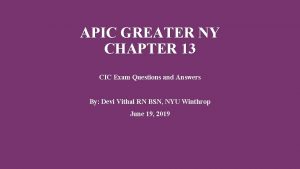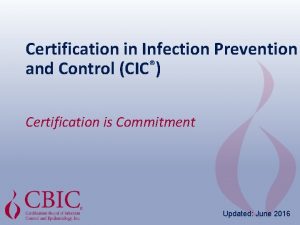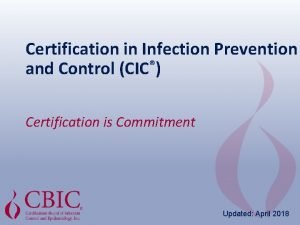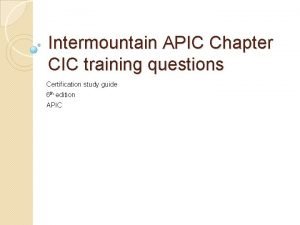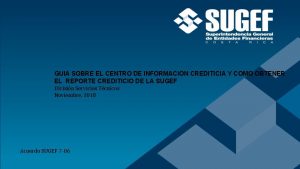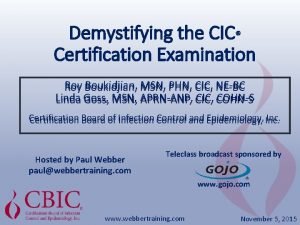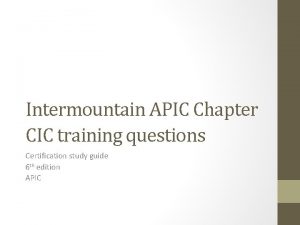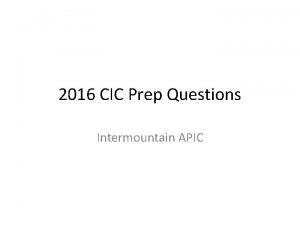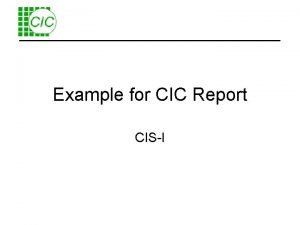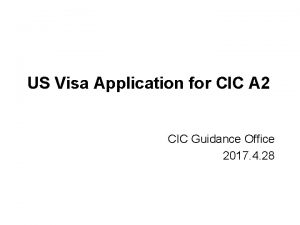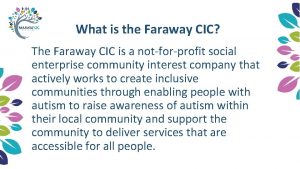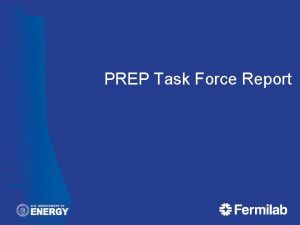CIC Prep Questions Education and Research 1 The












- Slides: 12

CIC Prep Questions Education and Research

1. The purpose of using a Chi-square test is to determine the A. B. C. D. difference between two means association between variables measurement of central tendency deviation from a normal distribution Discussion: 1. What can we exclude?

2. Which of the following objectives would be at the application cognitive level? A. B. C. D. List the 6 steps in the use of an alcohol hand rub Discussion: solution 1. What are cognitive levels? Differentiate between methicillin sensitive and 2. Bloom's Taxonomy of methicillin resistant organisms Cognitive Development 1. Knowledge Demonstrate the proper cleaning and 2. Comprehension disinfection of endoscopic equipment 3. Application Define symptoms of infection in institutionalized 4. Analysis geriatric patients 5. Synthesis 6. Evaluation

3. To compare surgeon-specific surgical site infection (SSI) rates internally and externally, the infection preventionist (IP) should use the number of A. B. C. D. surgeons with SSIs risk categories procedures performed surgical site infections Discussion: 1. What is the main problem? 2. What are we comparing (denominator)?

4. Which of the following is the BEST example of a risk-adjusted surveillance rate? A. bloodstream infections per 1, 000 patient days Discussion: 1. What is the problem? B. urinary tract infections per 100 patient 2. What risk factors are discharges involved? C. cases of ventilator-associated pneumonia per 1, 000 ventilator days D. surgeon-specific surgical site infections per total number of operative procedures

5. In a home health agency, an infection preventionist (IP) is analyzing central line infections. Which of the following is MOST essential for analysis? A. total number of device days B. patients' principal diagnoses C. documentation of type of catheter D. physician diagnosis of bacteremia Discussion: 1. What are we analyzing? 2. What risk factors are involved? 3. Does home health vs. acute care make a difference?

6. A. B. C. D. Adult learners are often motivated to learn by: 1. The need for new skills 2. Professional standard mandates 3. Desire for promotion and increased salary 4. Changing cultural expectations 2, 4 1, 3 3, 4 1, 4 Discussion: 1. What are the main motivating factors for adult learners?

7. A. B. C. D. Programs to build infection prevention competency are traditionally focused on a combination of skill and ability. Today, however, competency may include which of the following additional components? 1) Emotional intelligence 2) Cultural diversity 3) Communication methods 4) Effectiveness within a team Discussion: 1, 2, 3 1. What are the main motivating factors for adult learners? 2, 3, 4 2. What are the most important 1, 3, 4 for working in a team? 3. Which is least important? 1, 2, 4

8. A. B. C. D. Many infection prevention educational programs address behavioral change. To achieve sustainable success following initial training, the IP must focus on which aspect of behavior? Avoidance of behavior change Repetition and reinforcement Need for approval and recognition Critical thinking and judgment Discussion: 1. Continuing with the Adult Learner theme… 2. What leads to the best long-term success?

9. The IP has received feedback from course attendees that the didactic component of the program is too lengthy and difficult. Which training component should the IP now re-evaluate for its effectiveness? A. Laboratory-based simulation training B. Supervised clinical practice in patient care areas C. The classroom portions of the program D. The testing requirements for course completion Discussion: 1. Continuing with the Adult Learner theme… 2. What leads to the best long-term success? 3. Which is least important for the Adult Learner?

10. Routine surveillance identified an unusually high number of methicillinresistant Staphylococcus aureus (MRSA) infections. What type of study should the infection preventionist (IP) do to determine the reason for this cluster? A. B. C. D. cohort case-control longitudinal observational Discussion: 1. Prospective vs. Retrospective study design? Case controlled studies compare groups retrospectively. They seek to identify possible predictors of outcome and are useful for studying rare diseases or outcomes.

